
As I mentioned the other day, I enjoyed the Jelly Roll, because I was able to work with a wide variety of coordinating fabrics. I think my favorite in this set, though I do like them all, are the pieces with holly and ornaments. I also liked the diagonal striped fabrics as well.
Aside from the grain problems, the Jelly Rolls provide a quick start for a quilt. I am not saying that this quilt is quick since you haven’t seen the finished piece yet! I don’t really believe in the concept of quick quilts/Quilt in a Day for myself. I think process is important and I think that quilts take longer than a day. Why do you think I make receiving blankets as baby gifts?

I have worked with my child a lot on learning styles, and strategies for successful learning. I have learned a lot from his teachers and the other professionals that work with him about learning styles, which has made me examine my own style of learning. I know that I learn best by someone showing me what to do and then doing it myself. I also learn okay from looking at pictures/diagrams. I don’t learn well by reading instructions. This is probably one reason why I don’t use a lot of patterns. It takes me too long to decipher them.
First, I sorted the strips into sets of two. I decided which strips I wanted to be in the same block as package and bow.
I cut pieces, as designated by the pattern, from the Jelly Roll strips and then I needed a way to keep them together. I don’t have the clips that Fons & Porter use, so I used my machine quilting safety pins. They are pretty sharp so they went through 4 squares, 3 rectangles and two strips pretty well.
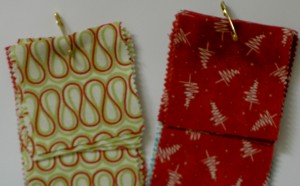
I had large pieces of leftover strips and I couldn’t figure out what I was doing wrong. I went back to the directions and, finally, figured out that I needed to cut more bow and package pieces. From each strip needed to be cut enough pieces for a bow and a package.

I did that extra cutting (more TV watching!) and then rearranged the new strips so that they had different mates for the second round of strips.

One step in the process is to put the bow together. This step involves triangles, but uses the square-into-triangle method to create the triangles at the top of the package.
The directions show the following:

I think it is pretty hard to show this step in directions, especially for someone, like me, who doesn’t use a lot of patterns. I don’t know all the conventions that have been established.
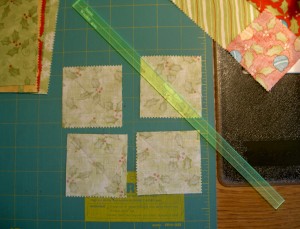
First, I marked all the squares so I would know where to sew. This was part of the meditation of this quilt that I alluded to in the previous Jelly Roll post. This kind of step can really get on my nerves. I didn’t let it; I just sat there with my pencil and ruler and drew lines. I didn’t mark all of the squares at once, but did them in little batches as I needed them.

One thing the directions do not show is that the square will overlap the middle rectangle when you lay it out to make the bow. The directions above show that the square fits exactly over the outside package rectangle. I worry about this kind of thing, because I expect directions to be accurate. Now, I don’t know the limitations of creating drawings in a pattern (on my list to find out about!), but words can certainly be included to explain that layout information. This is not a criticism, just an observation based on my style of working with patterns.
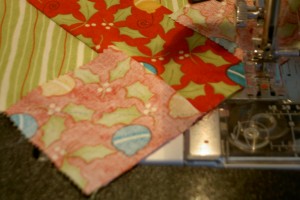
In real life, above is how the directions say to add the triangles to the corners of the package part of the block to make the bottom of the bow. TFQ and I talked about this strategy when I first bought the pattern. I think this technique makes it less intimidating for those afraid of bias. I was a little lazy and just did it this way.
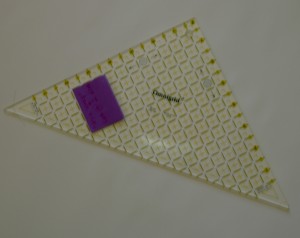
One problem I found with working with THIS pattern using a Jelly Roll is that I only had a certain amount of fabric. When I cut something wrong, I was short. This happened twice. Once with these triangle and I was able to use the Omnigrid triangle ruler to cut some triangles instead of squares, which gave me enough fabric to finish. The other time I just had to add a piece to another piece to make the strip long enough. Working through the process.

There is a lot going on in the photo above. First, even though I tried to mix up the fabrics for the second round of block making, I did keep some the same. The two above are an example of how the blocks looks when you just switch where you put the fabrics.
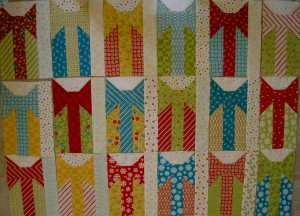
Second, I had to pick the quilt up off the floor earlier in the week where it was laid out while I pieced various bits. Since it is a scrappy quilt, I wanted to make sure that all the pieces stayed in their place. I drew a quick sketch of the block layout and then made numbers to pin to each block.
Third, not all of the sashing parts were sewed together so I sewed all the sashing squares (cornerstones) to the sashing strips and then pinned the larger pieces to the quilt blocks in such a way that I will know how to sew them when I get to that step.
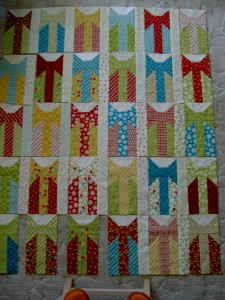
Why, you ask, were these on the floor and NOT on the design wall? Because the Tarts are still on the design wall! Why didn’t I set up the portable design wall? I don’t know; I didn’t think of it. Yes, those are my toes in my orange wool slippers and, yes, I am standing precariously (joke!) on an IKEA stool (highly recommended for their stability) to not succeed in taking a photo of the whole quilt for you.